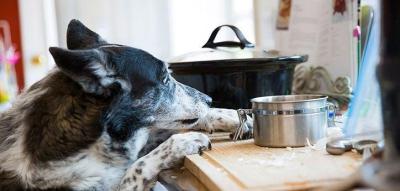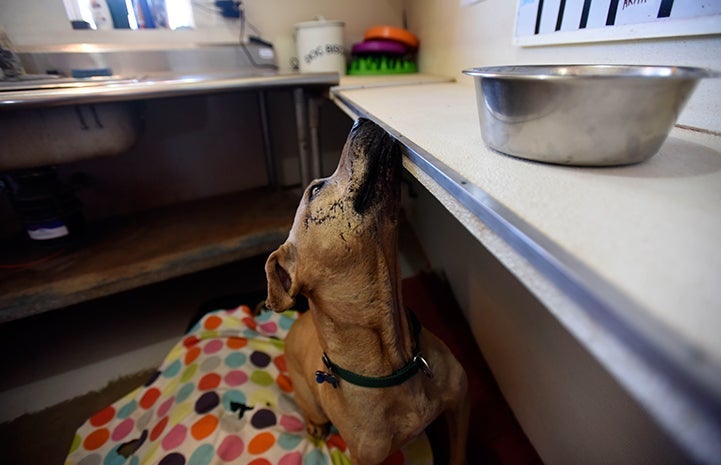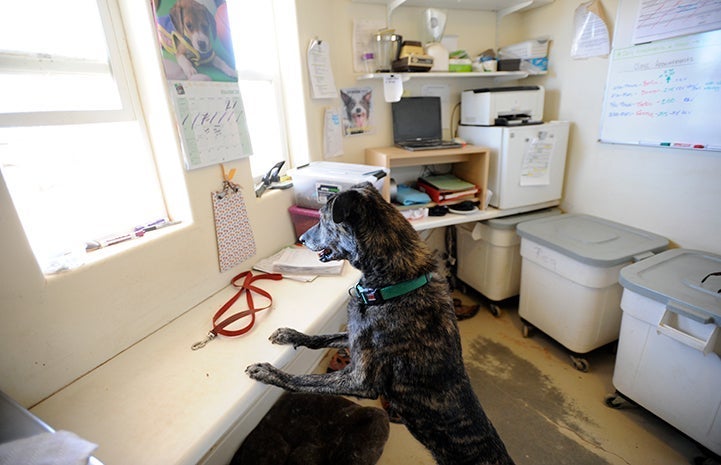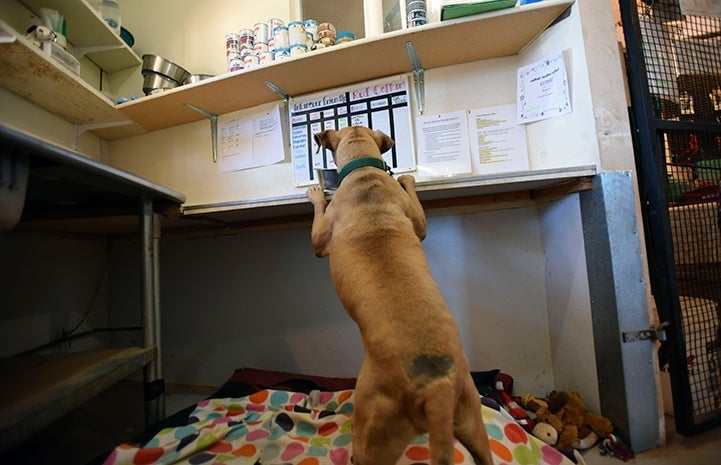
Dog Counter Surfing: Prevention and Deterrents
You put food on the kitchen counter and turn your back. Moments later, the food has vanished, and your dog is standing next to the counter licking their lips. Has this scenario happened in your house? If so, you have a pooch who’s a counter surfer. Here are some tips to help prevent dog counter surfing and teach your pup to leave items alone.
What is dog counter surfing?
It’s called counter surfing when your dog jumps up on the kitchen counter and steals food (or other items). Agile dogs might jump up with all four paws on the counter while other dogs, those who are tall enough, prop just their front legs on the counter tops to reach items.

Why does my dog counter surf?
Dogs counter surf typically because they have learned that kitchen counters are an easy source of yummy snacks. When a dog (or any animal for that matter) behaves in a certain way and that behavior is rewarded or reinforced, they're more likely to repeat that behavior in the future. Finding food on the counter when they jump up is a great reward. Dogs are optimists and opportunists, so even if your dog has only found food on the counter once or twice, they will keep on jumping up to look for it.
How can I prevent my dog from getting on counters and tables?
The simplest solution, of course, is to manage the situation so that your dog doesn’t have access to food on the counters. Here are some tips:
Home starts with you
- Never keep food on your counters. If your dog doesn’t find any food, they're not getting rewarded for counter surfing.
- Wipe the countertops thoroughly when you are done cooking so that there’s no delicious residue for the dog to lick up. Licking something tasty on a counter can be just as rewarding as finding a piece of food to snack on.
- Crate your dog during meal preparation. The process of cooking tends to involve food spread out on the counters, making it easy for your dog to snag a morsel when you’re not looking. If you don’t have a crate, you can use a baby gate in the doorway to restrict access to the kitchen or put the dog in another room while you cook.
The main objective here is to arrange your environment (the kitchen and countertops) so that the dog does not have the opportunity for reinforcement (finding food), which makes them more likely to jump up on the counter in the future.

How to prevent counter surfing
To discourage dog counter surfing, there are a couple behaviors you can teach your pup. “Leave it” is a useful cue for many situations — not the least of which is managing counter surfing. To start training your dog to leave it, go somewhere quiet and less exciting to the dog than the kitchen. Here are the steps to follow:
- With a treat in both hands, place your hands behind your back.
- Make a fist with one hand and offer that hand to your dog, letting them sniff your fist.
- Say “leave it,” and wait until they're done sniffing. As soon as they're done sniffing, say “yes” or click with a clicker and offer your dog the treat from the other hand.
- Keep doing this until your dog immediately stops sniffing your hand when you say “leave it.” When this happens consistently, you are ready to move on to the next step.
- Start by leashing the dog, and then toss a treat outside of their reach. Say “leave it,” and wait until your dog stops sniffing and pulling toward the treat.
- When the dog stops sniffing and pulling, say “yes” (or click) and give them a treat that they like even more than the one on the floor. Over time, by practicing this exercise, your dog should stop pulling as soon as you give the “leave it” cue.
Make sure the treats with which you are rewarding your dog are especially tasty, not just plain old kibble. By doing so, you are teaching your dog that asking them to leave it doesn’t mean they won’t get anything. (On the contrary, they might get something more delicious instead.) When trying to dissuade a counter surfer, you need to help them learn that leaving the human food alone is more rewarding than counter surfing.
“Off” is another useful cue to teach your counter surfer. Here’s how to do it:
- When the dog jumps up onto the counter in search of food, put a dog treat in front of their nose. When you have their attention, use the treat as a lure to guide them off the counter and onto the floor, saying “off.”
- When their feet hit the ground, say “yes” (or click) and give them the treat.
- After practicing this exercise three or four times, say “off” instead of placing a treat in front of their nose to lure them off. If the dog jumps off the counter, praise them, say “yes” (or click) and give them a treat.
- If the dog doesn’t jump off, you might need to lure them off the counter with treats a few more times before they figure out that “off” means that their paws should come off the counter and go back on the floor. Some dogs learn the cue quickly while others take a little more time. Your dog is an individual and will learn at their own pace.

You can also train your dog to go to their bed or special place while you cook or prepare food. This cue is useful when your dog is hanging out in the kitchen with you and starts getting a little too interested in the food, but your hands are busy so you can’t put them in the crate or otherwise relocate them. Here are the steps:
- Begin by tossing some treats onto a dog bed or mat, and when your dog goes over to investigate, say “yes” (or click).
- After you do this several times, your dog will probably start going over to their bed without any treats to prompt them. When they start walking over to the bed, say whatever cue you want to use (for example, “bed”). Then when they get there, mark it with a “yes” or click, and give them some treats.
Obviously, these strategies only work when you are there to give the cue. When you’re not going to be around, make sure you remove temptation either by blocking off access to the kitchen or by keeping the counters clear of food. Remember, dogs are opportunists, so it’s unfair to expect your dog to ignore delicious food that's within their reach.
